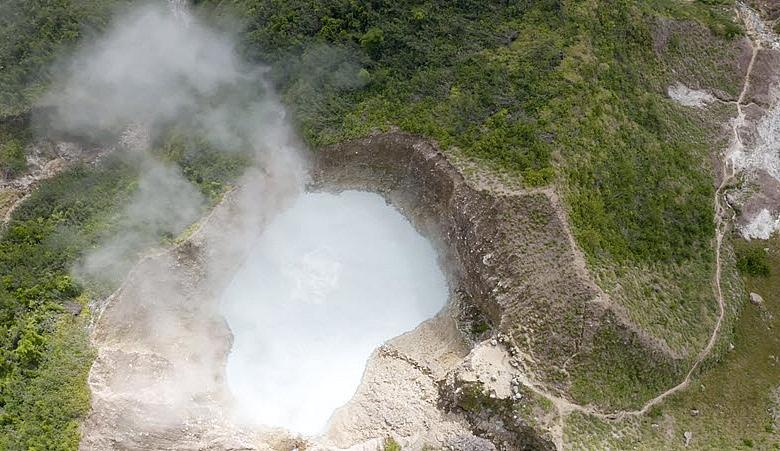Boiling Lake

The Boiling Lake is one of Dominica’s most spectacular natural wonders, and it has a rich biodiversity. It is located in the Morne Trois Pitons National Park, a UNESCO World Heritage Site. It is the second-largest hot lake in the world, after Frying Pan Lake in New Zealand. With a diameter of approximately 200 feet (60 meters), this bubbling cauldron of geothermal activity is constantly enveloped in a mist of steam and rising volcanic gases. The water temperature along its edges can range from 180 to 197°F (82 to 92°C), while the center remains in continuous boiling.
Surrounded by lush rainforests, rugged mountains, and sulfur-streaked landscapes, the Boiling Lake has intrigued adventurers, scientists, and historians alike.
Geological Significance of Dominica’s Boiling Lake
The Boiling Lake is a flooded fumarole, meaning it is formed by an opening in the Earth’s crust that emits volcanic gases and steam. It sits within the geothermal zone of the Valley of Desolation, an area known for its bubbling mud pools, fumaroles, and sulfur vents.
The lake’s heat source comes from magma beneath the Earth’s crust, which superheats water that seeps into underground chambers. As steam and gases rise, they heat the lake, causing its constant boiling and the thick clouds of vapor that hover over it.
While the lake is one of the most famous geothermal sites in the Caribbean, it is also known for its unpredictable fluctuations.
Historical Observations and Water Level Changes
The Boiling Lake was first documented in 1870 by Edmund Watt and Dr. Henry Alfred Alford Nicholls, two Englishmen working in Dominica at the time. They recorded its boiling activity and noted its unusual location deep within Dominica’s mountainous interior.
Further studies were conducted in 1875 by Henry Prestoe, a government botanist, and Dr. Nicholls. They measured the water temperature along its edges at 82 to 91.5°C (180 to 197°F) and estimated its depth to be at least 195 feet (59 meters).
Fluctuations in the Lake’s Water Levels
Throughout history, the Boiling Lake has seen dramatic changes in water levels. Some of the most significant recorded events include:
- 1880: A nearby phreatic eruption (steam explosion) caused the lake to temporarily disappear, leaving only a hot, steaming hole in the ground.
- 2004-2005: A similar steam-driven eruption led to a significant drop in water levels. Within months, the lake refilled, but scientists monitored the area closely for increased volcanic activity.
- 2016-2017: Another mysterious water level drop raised concerns among geologists. The lake shrank to a small bubbling pool, then refilled again over several months.
The Boiling Lake Trail: A Challenging Adventure
Reaching the Boiling Lake requires completing one of Dominica’s most difficult hiking trails. The Boiling Lake Trail is an 8-mile (13-kilometer) round-trip trek that takes between 6 to 8 hours to complete.
Key Landmarks Along the Trail
- Titou Gorge – The trail begins near this beautiful rock canyon, where hikers can swim in refreshing waters before or after their journey.
- Breakfast River – A rest stop and water refill point early in the hike.
- Morne Nicholls – A steep climb leads to this mountain peak at 3,168 feet (966 meters), offering panoramic views of Dominica’s interior.
- Valley of Desolation – A dramatic geothermal zone filled with boiling mud pits, sulfur vents, and steaming rocks.
The final stretch leads to Boiling Lake, where hikers witness one of nature’s most breathtaking geothermal phenomena.
Flora and Fauna Along the Trail
The Boiling Lake Trail passes through multiple ecological zones, ranging from dense rainforests to barren volcanic landscapes. This diverse environment is home to a wide variety of plant and animal species unique to Dominica.
Plant Life
- Rainforest Canopy – The lower sections of the trail are dominated by towering trees, vines, and epiphytes.
- Tree Ferns & Mosses – Higher elevations feature thick moss, ferns, and orchids clinging to damp surfaces.
- Barren Geothermal Zone – Near the Valley of Desolation, vegetation thins out, replaced by sulfur-stained rocks and mineral deposits.
Wildlife
- Birds – The trail is home to imperial amazon parrots, Dominica’s national bird and red-necked amazon parrots.
- Mammals – Hikers may spot agoutis, wild pigs, and opossums scurrying through the undergrowth.
- Reptiles & Amphibians – Small tree frogs, lizards, and snakes thrive in the moist rainforest habitat.
Trail Maintenance and Safety
The Boiling Lake Trail is maintained by Dominica’s Forestry, Wildlife, and Parks Division. However, due to the island’s high rainfall and volcanic activity, the trail can become treacherous. Hikers are advised to:
- Hire a local guide – The trail can be difficult to navigate without an experienced guide.
- Start early – Afternoon rain showers can make the trail slippery and dangerous.
- Wear proper gear – Sturdy boots, rain jackets, and sufficient water are essential.
Notable Incidents on the Boiling Lake Trail
While the Boiling Lake Trail is a thrilling adventure, it can also be dangerous.
- 1900 Tragedy: A hiker and his local guide were overcome by volcanic gases near Boiling Lake, leading to their deaths. This incident was one of the first recorded fatalities on the trail.
- 2025 Incident: On February 20, 2025, David Stein, a 67-year-old American tourist, tragically fell to his death while hiking the Boiling Lake Trail with his wife. Emergency responders arrived quickly, but Stein succumbed to his injuries.
These incidents serve as a reminder of the dangers posed by the rugged terrain, unstable ground, and toxic volcanic gases.
Why Boiling Lake Is a Must-See Destination
Despite its challenges, the Boiling Lake remains one of Dominica’s most extraordinary natural wonders. It offers:
- A one-of-a-kind geothermal experience – Few places in the world have a lake constantly boiling from volcanic activity.
- Spectacular hiking landscapes – The trail passes mountains, rivers, and geothermal fields unique to Dominica.
- A UNESCO World Heritage site – The Morne Trois Pitons National Park is one of the most preserved ecosystems in the Caribbean.
For those seeking an unforgettable adventure, the Boiling Lake Trail offers a challenging yet rewarding journey into one of the Earth’s most unique volcanic landscapes.




